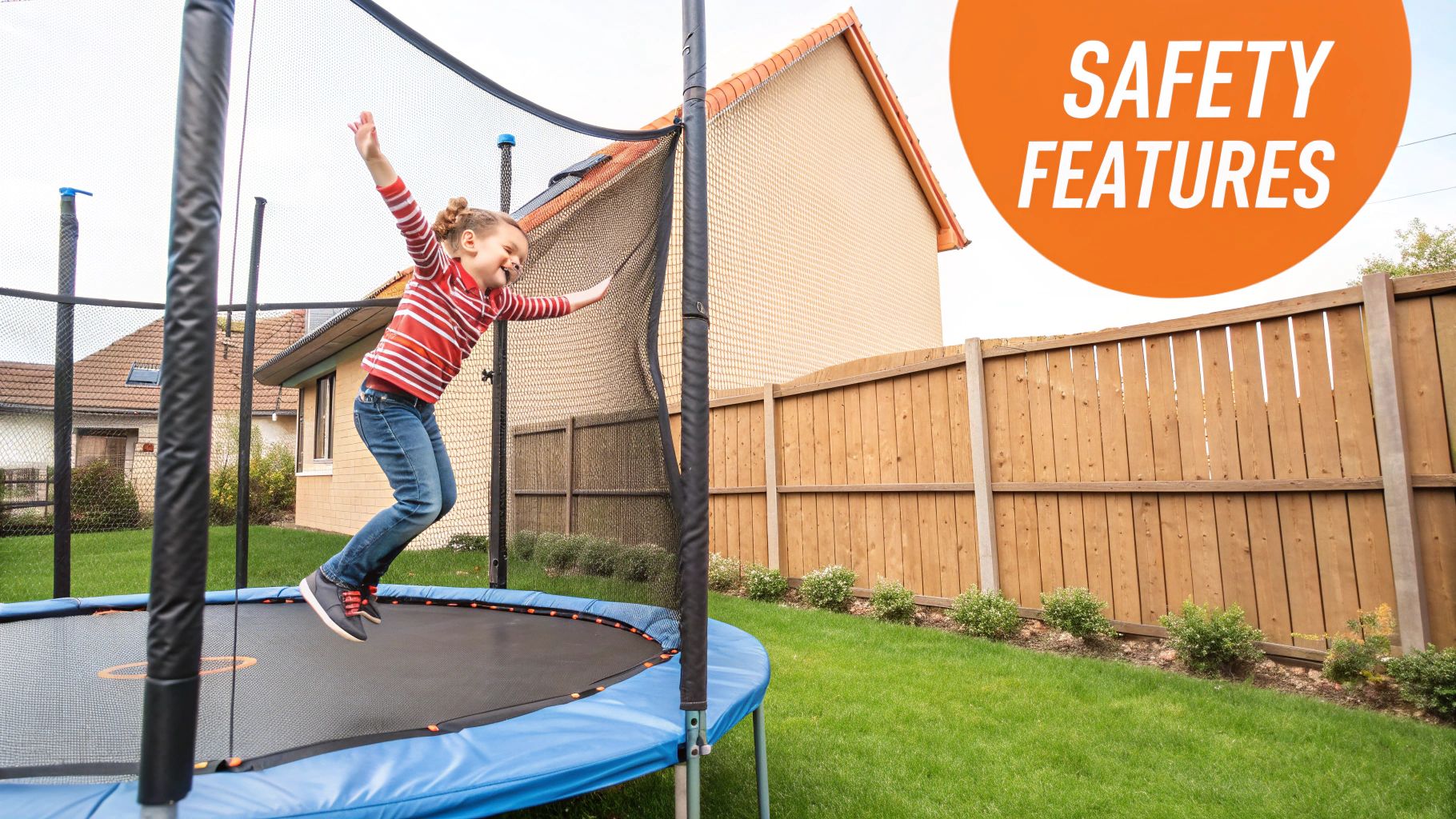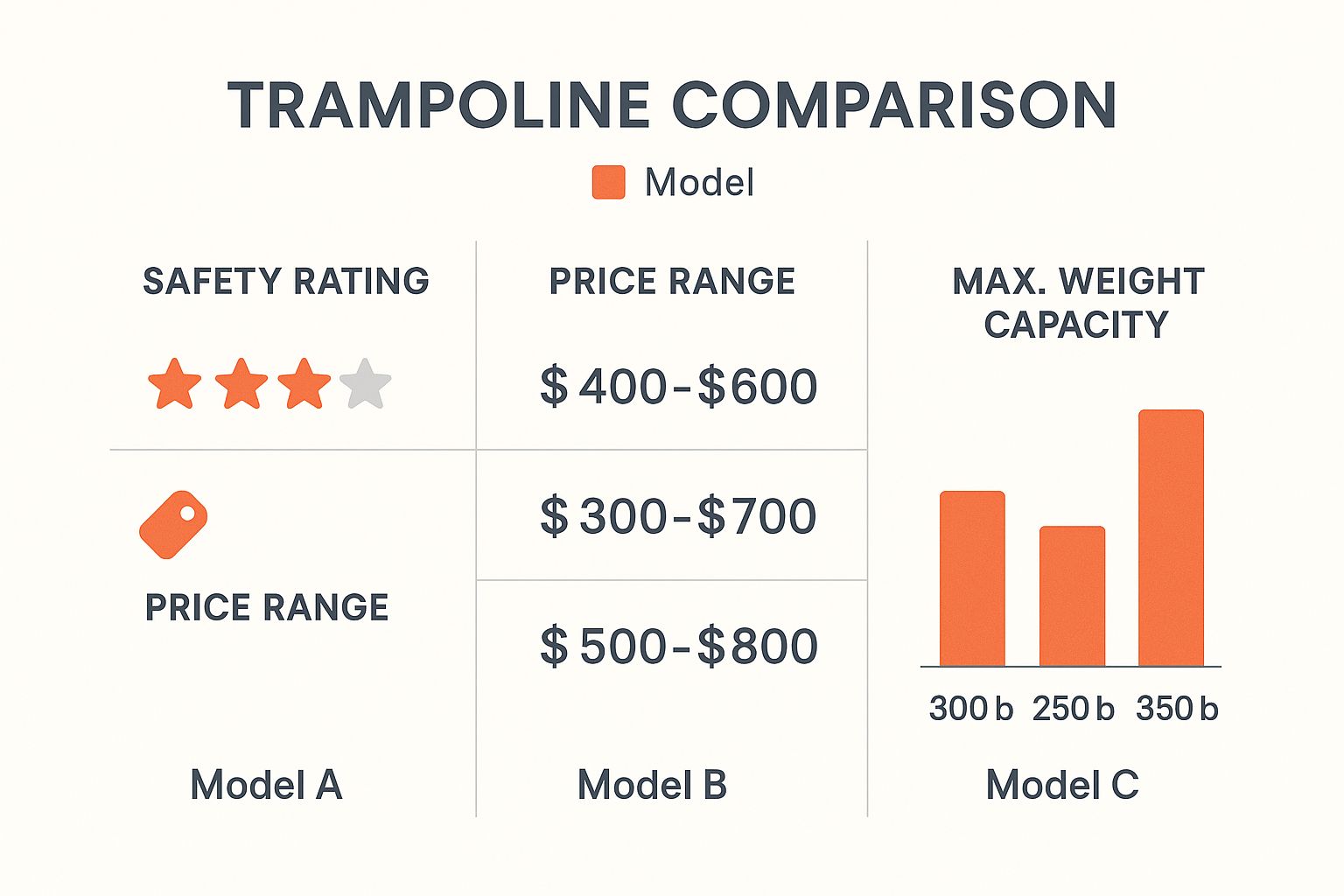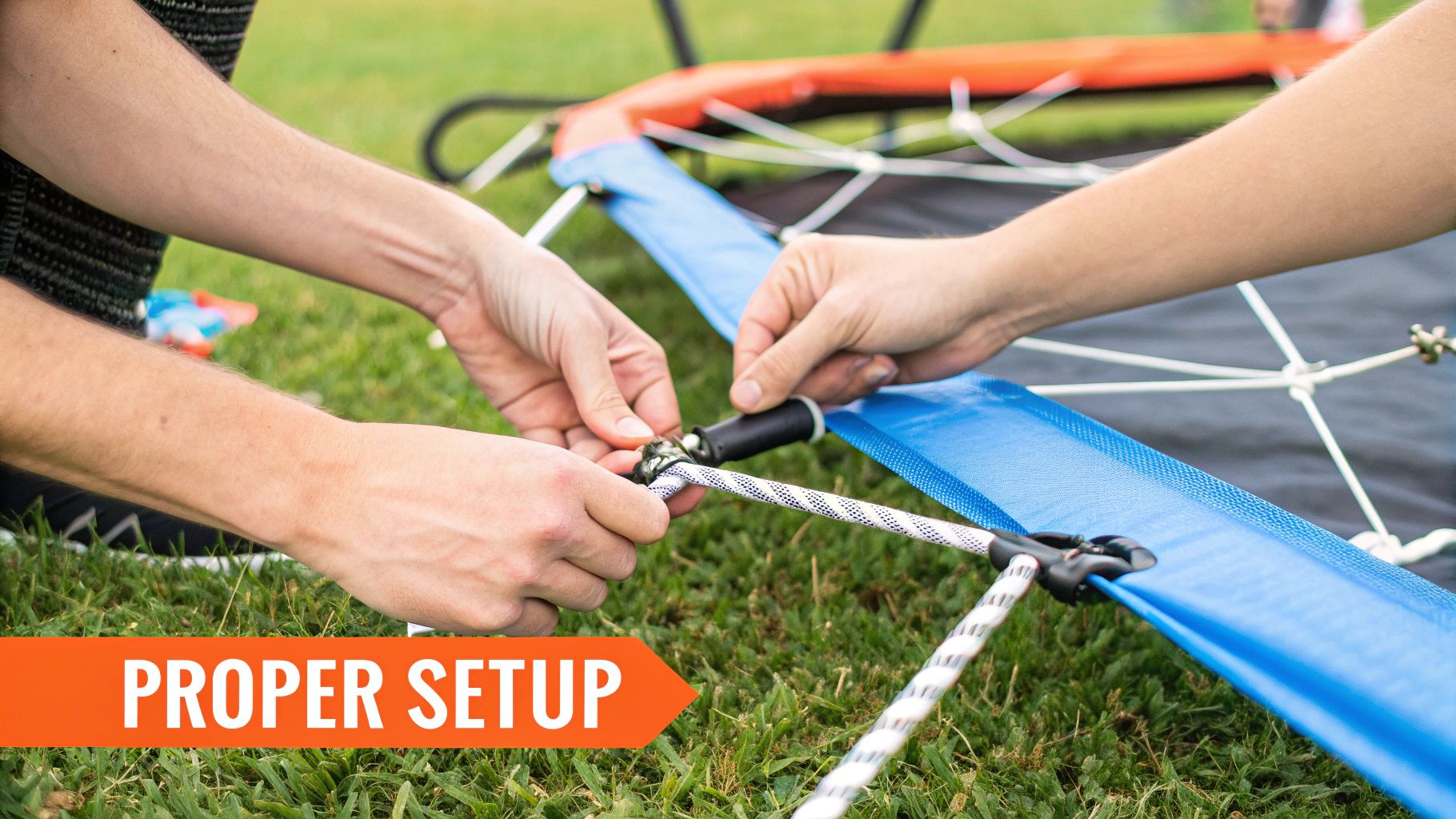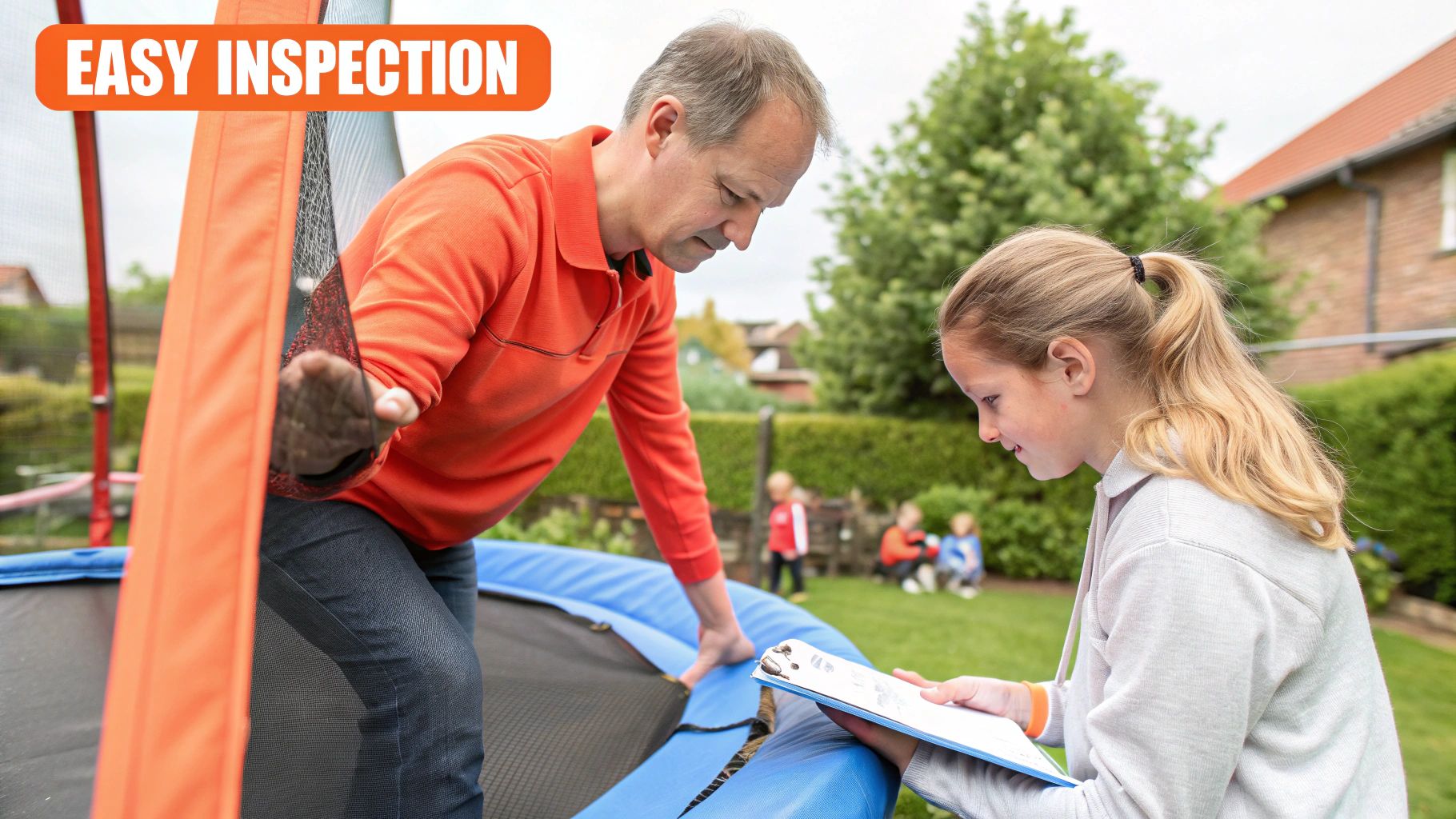-
CALL US:
- (866) 952-3456
When you start shopping for a trampoline, it's easy to get lost in the details of size and bounce. But the most important features have nothing to do with fun and everything to do with safety. The gold standard for a safe kids' trampoline is a springless model. These designs get rid of the dangerous pinch points and hard metal edges found on older trampolines.
Combine that with a strong, flexible safety enclosure net and a robust, galvanized steel frame, and you have a recipe for drastically reducing the most common trampoline injuries.
Before we jump into specific features, let's get real about why this decision is so important. A trampoline can be an amazing source of fun and a great way for kids to burn off energy, but choosing one isn't like buying any other backyard toy. The idea isn't to scare you away from them, but to arm you with the knowledge to make a smart choice. Once you understand the common risks, you can effectively prevent them.
When you picture a trampoline accident, you probably imagine a kid flying off the side. While that's definitely a major concern, a surprising number of injuries happen right on the jumping surface itself. Kids colliding, landing funny, or hitting the frame and springs are the quiet culprits behind many trips to the emergency room.
The hard truth is that trampolines are linked to a staggering number of preventable injuries every year. In the United States, they're responsible for around 100,000 emergency room visits annually. It's not just a freak accident here and there.
According to the U.S. Consumer Product Safety Commission (CPSC), over 110,000 children needed emergency care for trampoline-related incidents back in 2018. The youngest kids are especially at risk—they are 14 times more likely to get hurt than older, heavier jumpers. You can dig into more trampoline accident statistics to see for yourself why picking the safest model is so critical.
This data tells a very clear story: a trampoline's design directly shapes how safe it is. A well-built product is designed to anticipate these risks and has features built right in to stop them from happening.
Choosing the safest trampoline isn't just about buying a piece of equipment; it's about creating a controlled environment for fun. The right gear is your first and best defense against common accidents.
To pick the right trampoline, it helps to know what you're trying to prevent. The most common accidents usually boil down to a few key scenarios:
Keeping these risks in mind helps you see why the safety features we're about to cover are so important. Each one is a direct solution to one of these potential dangers, turning a risky activity into a much safer way for your family to have fun.

When you're picking out a trampoline for your kids, it’s easy to get lost in the marketing jargon. But choosing the safest option means looking past the flashy ads and really understanding how each part works to keep your child protected.
It's a lot like buying a family car. You wouldn't just pick one based on the paint color; you’d dig into the details about airbags, brakes, and the frame. That same level of attention is exactly what you need when shopping for a trampoline.
Let's break down the non-negotiable features that separate a high-quality, safe trampoline from something that could be a genuine hazard in your backyard.
If there’s one feature that’s absolutely critical on any modern trampoline, it's the safety enclosure net. Its job is simple but essential: to stop kids from falling off the trampoline, which is how the most serious injuries tend to happen.
Think of it as the guardrails on a high balcony. Without it, one wrong step could lead to a disastrous fall. A good net should be made from a tough, UV-resistant material that won’t get brittle and tear after a few months in the sun.
The most important detail, though, is how it attaches. The net must connect to the jumping mat inside the springs and frame. This way, if a child bounces into the net, they are guided back toward the safe center of the mat—not into the hard steel frame or the dangerous springs. Nets that attach to the outside edge of the frame still leave those hazards wide open.
Next up are the spring cover pads. These are the thick, cushioned pads that sit directly over the trampoline's springs and the steel frame. Their entire purpose is to create a soft buffer between the jumping area and all that hard metal.
Without good padding, a jumper could easily slip through the gap between the mat and frame, leading to nasty pinched skin, sprains, or even broken bones. When you're inspecting them, look for pads that are thick, wide enough to completely cover the springs and frame, and secured tightly so they can't shift around during use.
The outer material is just as important. High-quality padding is wrapped in a weatherproof, UV-protected vinyl or PVC shell. This keeps it from cracking, fading, and losing its protective cushion after a season out in the elements.
The frame is the trampoline's skeleton. A weak frame makes for an unstable, wobbly, and unsafe product. The safest trampolines for kids are built with frames made from heavy-gauge, galvanized steel.
Galvanizing is just a fancy word for coating the steel in a layer of zinc to stop rust and corrosion from taking hold. A rusty frame is a weak frame, and it could fail under the constant stress of jumping. Look for models with solid, welded joints and a good number of legs for the trampoline’s size to ensure it stays put.
While modern safety features like nets and pads have made trampolines much safer, they don't eliminate all risk. The frame and springs can still account for 20% of injuries when jumpers hit them, even with padding. This is a powerful reminder of why a smart design that keeps kids away from these parts is so crucial. You can find more data on this topic over on Springfree Trampoline's blog about injury statistics.
To help you keep track of what really matters, here's a quick checklist of the key safety features to look for.
| Safety Feature | What It Prevents | What to Look For (Quality Indicators) |
|---|---|---|
| Enclosure Net | Falls from the trampoline surface, which are the leading cause of major injuries. | UV-resistant material, attached inside the springs, and a self-closing entrance. |
| Spring Cover Pads | Contact with hard springs and the steel frame; prevents limbs from slipping through gaps. | Thick foam (at least 1 inch), wide enough to cover all metal, weatherproof vinyl/PVC cover. |
| Frame | Structural collapse and instability during use. | Heavy-gauge, galvanized steel (rust-proof), welded T-joints, and multiple U-shaped legs. |
| Jumping Mat | Mat tearing or detaching from springs, causing a sudden fall. | UV-resistant polypropylene, reinforced stitching around D-rings, and a smooth, non-abrasive surface. |
| Zipperless Entry | A child forgetting to close the entrance and accidentally bouncing out. | An overlapping net design that automatically closes, with no zippers or clips to break or forget. |
This table gives you a solid foundation, ensuring you're focusing on the components that truly make a difference in keeping backyard fun safe.
The jumping mat itself is a core safety component. A good mat gives a consistent, predictable bounce, which helps reduce the chances of an awkward landing. Most are made from polypropylene, a tough material known for its strength and ability to stand up to the sun.
Pay close attention to the stitching around the D-rings where the springs attach. This is where all the force is concentrated, and if that stitching fails, the jumping surface can suddenly give way. A well-made mat will feel sturdy and durable, not thin or flimsy.
Finally, think about how your kids will get on and off. The safest trampolines now feature an overlapping, zipperless entryway in the enclosure net.
This clever design gets rid of the risk of someone forgetting to zip the opening and accidentally bouncing out. We all know kids can be forgetful, and traditional zippers can be left open or simply break over time, making the net useless. An overlapping entrance automatically closes behind the jumper, making sure that protective barrier is always there when it's needed. It's a small detail that makes a huge difference.
When you’re looking at trampolines, the single biggest decision you'll make boils down to one thing: springs or no springs. This choice completely changes the safety game. It’s a bit like comparing a classic car with stiff, old-fashioned suspension to a modern vehicle with a system designed to absorb every bump. They both drive, but one offers a much safer, more predictable ride.
Now, this isn't about finding one single "best" trampoline for every family. Your budget and what you’re looking for will play a big role. Instead, think of this as a straightforward, head-to-head comparison to show you exactly what each design means for safety, so you can make a decision you feel good about.
This chart gives you a quick visual on how safety, price, and weight limits often relate.

As you can see, trampolines with higher safety ratings tend to cost more, but they also typically hold more weight, which points to a sturdier build overall.
Traditional trampolines are the ones most of us grew up with. They use a ring of coiled metal springs to connect the jumping mat to the steel frame, and this design has been the standard for decades. You'll find them everywhere, and they're usually the more affordable option.
But from a safety standpoint, those metal springs create some real problems. The springs and the frame form a hard, unforgiving ring right at the edge of the jumping area. Even with padding over them, that perimeter is still a major impact zone.
The main dangers with spring-based designs are:
While today’s spring trampolines are much safer than the ones from our childhood—thanks to better padding and nets—that fundamental risk of a metal-ringed jump zone is still there.
Springless trampolines represent a huge leap forward in safety engineering. Instead of metal coils, they use things like flexible composite rods or heavy-duty elastic bands that are positioned underneath the jumping mat. It’s a clever design that takes the springs completely out of the picture.
By moving the bounce mechanism below the mat, these models get rid of the two biggest hazards: the hard steel frame and the metal springs. If a jumper gets too close to the edge, they just land on more of the soft mat or bump into the flexible net. There’s simply no hard edge to hit.
The real genius of a springless design is that it removes the problem instead of just covering it up. Rather than putting a pad over metal springs, it eliminates the springs altogether, creating a "soft edge" all the way around.
To get a clearer picture of how these two types stack up, let's look at them side-by-side.
This table breaks down the core safety differences you'll want to consider.
| Safety Aspect | Spring-Based Trampolines | Springless Trampolines |
|---|---|---|
| Edge Impact | Padded metal springs and frame create a hard perimeter. High risk of injury from landing on the edge. | The edge of the mat is soft and forgiving. The bounce mechanism is located safely beneath the mat. |
| Pinch Points | Gaps between springs create numerous pinch points for fingers, toes, and hair. | No springs means no pinch points. The design eliminates this common source of injury. |
| Gap Exposure | Padding can shift or degrade, exposing gaps between springs where limbs can get trapped. | No gaps to fall through. The jumping surface extends all the way to the enclosure net. |
| Frame Contact | The steel frame is a primary impact zone, located just under the pads at the edge of the jump surface. | The frame is situated well below the jumping surface, making it nearly impossible to land on during normal use. |
As you can see, the fundamental design of springless models inherently addresses the most common safety issues found in traditional trampolines.
Beyond the major safety differences, the two designs also feel different to jump on.
In the end, it’s a trade-off. You have to weigh the higher upfront cost of a springless model against its built-in safety advantages. While spring-based trampolines have certainly gotten better over the years, springless models were engineered from the ground up to eliminate the most frequent causes of trampoline injuries. For any parent putting safety first, that makes them a very compelling choice.

It’s easy to get caught up in the idea that bigger is always better, but when it comes to trampolines, that’s just not true. In fact, it's a common mistake that can actually make things less safe. The best trampoline isn't the biggest one on the market; it's the one that’s the right fit for your child's weight and your yard's layout.
Think of it like buying a bike. You wouldn't put a five-year-old on an adult-sized mountain bike—they couldn’t reach the pedals or control it properly. The same logic applies here. A trampoline that’s too big can be tough for a small child to handle, while one that's too small is a bad match for a growing teenager.
First things first, let's talk about your child. Manufacturers provide two key numbers for every model: the individual jumper weight limit and the total structural weight capacity. For everyday safety, the number you really need to pay attention to is that individual jumper limit.
Here's why a huge trampoline isn't great for a little kid: The bounce mat on a big model is designed for a heavier person's weight to activate it properly. A lightweight child just doesn't have the mass to control their bounce, which can lead to unpredictable, off-balance landings.
Once you’ve got a size in mind, it's time to head outside with a tape measure. A trampoline needs more than just enough space to sit on; it requires a totally clear, unobstructed bubble around it. We call this the safe clearance zone.
This buffer area is absolutely non-negotiable. It's what ensures that if someone does happen to fall off, they land on soft grass—not on a fence, the corner of a shed, or the patio.
Here’s how to measure your space the right way:
By taking the time to measure your yard and choose a size that allows for this critical safe zone, you're handling one of the biggest safety factors before the box even arrives. It’s a foundational step toward creating the safest possible space for backyard fun.
Even the safest trampoline you can buy becomes a hazard if it’s not put together and placed correctly. Think of proper installation as the final, critical step that activates all those safety features you just paid for. It’s what makes the difference between a safe product in a box and a genuinely safe play experience in your yard.
The assembly process isn't just about following a diagram; it's about building a stable foundation for years of fun. A rushed or incorrect setup can lead to a wobbly frame, an uneven bounce surface, or parts that fail under stress. This is one area where cutting corners just isn't worth the risk.
Before you even open the box, your most important job is finding the right spot. The ground has to be perfectly level. A slight slope might not look like much, but it can cause the trampoline to tip or put dangerous, uneven stress on the frame once kids start jumping.
Next, you need to create a "safe fall zone" around the entire perimeter. This is a non-negotiable clear zone, free from any and all obstacles.
This clear zone is absolutely critical. Interestingly, even as trampolines have gotten safer, injury rates have continued to climb, and a lot of that comes down to poor placement. Data shows that non-fatal trampoline injuries for children more than doubled in the early 2000s compared to the 1990s. You can read more about these trampoline injury trends and see why careful setup is so important.
When it comes time to build it, follow the manufacturer's instructions to the letter. Don't rush it. Make sure every single bolt is tight and every part is securely locked in place.
If the process feels overwhelming or you’re just not 100% confident you can get it perfect, don't hesitate to call in a professional. Getting expert help from local trampoline installation companies gives you peace of mind that the job was done right from the start.
A correctly assembled trampoline is stable, quiet, and secure. A poorly assembled one often wobbles, creaks, and poses a significant risk. Taking the time to build it right is a direct investment in your child's safety.
Proper placement and solid installation are the final pieces of the puzzle. They’re what transform a great product into one of the safest trampolines for kids, turning your backyard into a secure spot for fun.

Bringing home a safe trampoline is a great first step, but keeping it that way is an ongoing commitment. Think of it like owning a car. You wouldn't just skip the oil changes and then act surprised when the engine starts acting up, right? A trampoline is no different—it needs regular check-ups to make sure every single part is in good working order.
This isn't just about protecting your investment. It’s about protecting your family. A few minutes of inspection each season can help you spot small problems before they turn into serious safety risks. Honestly, this simple routine is one of the easiest ways to ensure you have one of the safest trampolines for kids on the block.
A simple, consistent inspection routine is your best friend here. At the start of each new season—especially after a long, harsh winter—just take a few minutes to run through this list. To make sure you’re being thorough, you can borrow principles from professionals who are great at implementing safety checklists, even if it's in a totally different industry. The core idea is the same: be systematic.
A single worn-out part can compromise the entire safety system of a trampoline. Identifying a stretched spring or a small tear in the net early allows you to order a replacement part before it fails completely.
Knowing when a part is officially past its prime is crucial. You don’t want to wait for something to actually break before you take action.
Making regular maintenance a habit turns your trampoline from a one-time purchase into a long-term source of safe backyard fun. It's a simple routine that pays off with priceless peace of mind.
Even after you've nailed down the safety features and planned the perfect setup, a few questions might still be bouncing around in your head. Let's run through some of the most common things parents ask, so you can feel completely confident about your new backyard addition.
This is, without a doubt, the number one rule of trampoline safety, and it all comes down to simple physics. When two people with different body weights jump together, the heavier person’s landing acts like a slingshot. It sends the lighter child flying—often uncontrollably—into the air.
This is called the "double bounce" effect, and it’s a leading cause of trampoline injuries, especially fractures and sprains from awkward, high-impact landings. Making the one-jumper-only rule a non-negotiable is the single best thing you can do to prevent the most common accidents.
Unless your child is a trained gymnast working with a professional coach, the answer is a hard no. It's incredibly dangerous for untrained kids to try flips, somersaults, or any other acrobatic stunts. One wrong move can easily lead to devastating head, neck, or spinal cord injuries.
Backyard trampolines are built for simple, recreational bouncing—not for gymnastics practice. Keep the fun focused on jumping up and down to avoid a truly life-altering injury.
Remember, a backyard trampoline is a playground, not a training facility. The fun comes from the simple joy of bouncing, not from attempting high-risk maneuvers that can have devastating consequences.
Most pediatricians and safety experts agree: trampolines are not for children under the age of six. Toddlers and preschoolers are still developing crucial coordination and bone density, which puts them at a much higher risk for injury. Their small bodies and wobbly balance just can't handle the forces of a trampoline, even a small one.
There are plenty of safer ways for little ones to get their energy out. If you're looking for ideas on creating a secure play space, our guide on swing set safety guidelines has some great tips that apply to all kinds of backyard equipment.
This is a big one that many parents forget to ask. Insurance companies often classify trampolines as an "attractive nuisance"—something on your property that could attract kids and pose a significant risk. Because of this, adding a trampoline can definitely affect your policy.
Your insurer might:
Before you even think about buying, make a call to your insurance agent. Be upfront about your plans and ask them point-blank how a trampoline will impact your coverage. That one phone call can save you from a world of financial trouble and legal liability down the road.
Feeling ready to buy but a little nervous about putting it all together? The expert technicians at Assembly Smart can make sure your new trampoline is installed perfectly, meeting every last manufacturer safety standard. Get your free quote and book your professional assembly today at https://assemblysmart.com for total peace of mind.